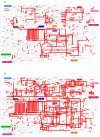Elucidation of the molecular envenomation strategy of the cone snail Conus geographus through transcriptome sequencing of its venom duct
- PMID: 22742208
- PMCID: PMC3441800
- DOI: 10.1186/1471-2164-13-284
Elucidation of the molecular envenomation strategy of the cone snail Conus geographus through transcriptome sequencing of its venom duct
Abstract
Background: The fish-hunting cone snail, Conus geographus, is the deadliest snail on earth. In the absence of medical intervention, 70% of human stinging cases are fatal. Although, its venom is known to consist of a cocktail of small peptides targeting different ion-channels and receptors, the bulk of its venom constituents, their sites of manufacture, relative abundances and how they function collectively in envenomation has remained unknown.
Results: We have used transcriptome sequencing to systematically elucidate the contents the C. geographus venom duct, dividing it into four segments in order to investigate each segment's mRNA contents. Three different types of calcium channel (each targeted by unrelated, entirely distinct venom peptides) and at least two different nicotinic receptors appear to be targeted by the venom. Moreover, the most highly expressed venom component is not paralytic, but causes sensory disorientation and is expressed in a different segment of the venom duct from venoms believed to cause sensory disruption. We have also identified several new toxins of interest for pharmaceutical and neuroscience research.
Conclusions: Conus geographus is believed to prey on fish hiding in reef crevices at night. Our data suggest that disorientation of prey is central to its envenomation strategy. Furthermore, venom expression profiles also suggest a sophisticated layering of venom-expression patterns within the venom duct, with disorientating and paralytic venoms expressed in different regions. Thus, our transcriptome analysis provides a new physiological framework for understanding the molecular envenomation strategy of this deadly snail.
Figures





References
-
- Cruz LJ, Gray WR, Olivera BM, Zeikus RD, Kerr L, Yoshikami D, Moczydlowski E. Conus geographus toxins that discriminate between neuronal and muscle sodium channels. J Biol Chem. 1985;260(16):9280–9288. - PubMed
Publication types
MeSH terms
Substances
Grants and funding
LinkOut - more resources
Full Text Sources
Research Materials

